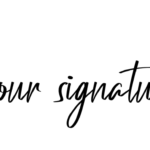As an artist, your signature is the ultimate branding tool. It is your mark of identity that sets you apart from the rest. Your signature should be unique, creative, and memorable. Your signature design can become your visual identity, which can be used on your artwork, promotional material, and even on your website. In this article, we will explore some unique and creative signature designs that you can use to create your own signature.
What is a Signature?
A signature is a handwritten or digital representation of an individual’s name or initials that is used to sign a document, artwork, or any other creative work. Signatures can be used as a means of identification, authentication, and branding.
Why is a Signature Important for Artists?
A signature is important for artists as it provides a means of identification, authentication, and branding. It can help to establish the artist’s identity and make their artwork more recognizable. It also adds value to the artwork and can increase its marketability.
Artists, whether they are painters, sculptors, or illustrators, know the importance of putting their signature on their work. A signature is more than just a way of identifying who created a particular artwork. It serves many purposes that are vital to an artist’s success. In this article, we will explore the reasons why a signature is important for artists, and how it can affect their career.
1. Authenticity and Provenance
One of the most important reasons why a signature is crucial for artists is to authenticate their work. A signature is proof that an artwork was created by a particular artist, and not a fake or forgery. Without a signature, it can be challenging to determine the authenticity and provenance of an artwork, which can significantly affect its value.
2. Establishing an Identity
A signature is also a way for an artist to establish their identity and create a brand for themselves. When an artist signs their artwork, they are putting their stamp on it, and it becomes a representation of their unique style and vision. A recognizable signature can help an artist build a following and establish a reputation in the art world.
3. Copyright Protection
A signature also helps an artist protect their intellectual property rights. In many countries, copyright laws protect an artist’s work from being copied or reproduced without their permission. A signature can act as evidence of ownership, and help an artist prove that their work has been copied or used without their consent.
4. Marketing and Sales
A signature can also be essential for marketing and sales purposes. When an artist signs their artwork, it becomes a valuable commodity that can be bought and sold. A signature can significantly increase the value of an artwork, and it can also help collectors and buyers identify the artist and their work. A signature can also help an artist build a relationship with their audience and collectors, which can lead to future sales and commissions.
5. Historical Significance
Finally, a signature can have historical significance. When an artist signs their artwork, they are leaving a mark that can last for generations. A signature can help historians and art experts trace the history of an artwork, and can also provide valuable insights into an artist’s life and career.
How to Create a Unique and Creative Signature?
Creating a unique and creative signature is not an easy task. It requires time, effort, and creativity. Here are some tips to help you create a unique and creative signature:
1. Use Your Name as a Starting Point: Your signature should be an extension of your name. You can start by experimenting with the different ways you can write your name. Try different fonts, sizes, and styles.
2. Add a Symbol or Icon: You can add a symbol or icon that represents your brand or identity. It can be a simple design that is easy to recognize and remember.
3. Experiment with Colors: Colors can add personality and character to your signature. You can experiment with different color combinations to find the one that best represents your style and personality.
4. Keep it Simple: A simple signature design is often the most effective. Avoid adding too many elements that can clutter your signature and make it hard to read.
5. Practice, Practice, Practice: Practice writing your signature until you find the perfect design. You can also ask for feedback from friends, family, or fellow artists to help you improve your signature.
Examples of Unique and Creative Signature Designs
Here are some examples of unique and creative signature designs that you can use as inspiration for your own signature:
1. The Initials: This signature design uses the artist’s initials as the main element. The initials are written in a unique and creative way, with a symbol that adds personality to the signature.
2. The Iconic Symbol: This signature design uses an iconic symbol that represents the artist’s brand or identity. The symbol is simple, memorable, and easy to recognize.
3. The Abstract Design: This signature design uses an abstract design that is unique and creative. It adds personality to the signature and makes it more memorable.
4. The Handwritten Signature: This signature design uses the artist’s handwritten signature as the main element. It adds a personal touch to the signature and makes it more unique.
Conclusion
Your signature is an important aspect of your branding as an artist. It should be unique, creative, and memorable. By following the tips and examples outlined in this article, you can create a signature that represents your brand and identity as an artist. Remember, practice makes perfect, so keep experimenting until you find the perfect design.



Add Comment